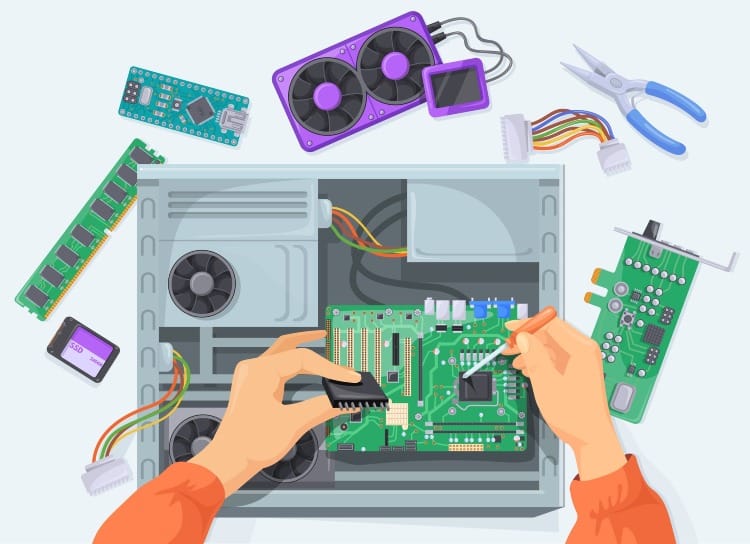RAM confusion got you scratching your head? You're not alone. With computers now coming with 8GB, 16GB, or even 32GB of RAM, figuring out what you actually need can feel overwhelming. Don't worry—we'll break it down in plain English so you can make the right choice for your needs and budget.
What is RAM and Why Does It Matter?
Think of RAM (Random Access Memory) as your computer's short-term memory or workspace. Unlike your hard drive, which stores files permanently, RAM temporarily holds the information your computer actively uses right now.
Imagine your computer is like a desk where you work. Your hard drive is like a filing cabinet across the room—it stores everything, but it takes time to walk over and get what you need. RAM is like the papers you spread out on your desk surface—everything you're currently working on is right there, ready to grab instantly.
RAM acts as your computer's short-term memory, storing data that your computer actively uses, allowing for quick access and smooth performance. When you don't have enough RAM, your computer starts using your slower hard drive as backup memory, which makes everything sluggish.
Here's what happens with different RAM amounts:
- Too little RAM: Your computer constantly swaps information between RAM and your hard drive, causing lag and freezing
- Just enough RAM: Everything runs smoothly for your typical tasks
- More than enough RAM: Extra headroom for multitasking and future software updates
The 2025 Reality Check: 8GB vs 16GB vs 32GB
The RAM landscape has shifted significantly in 2025. 16GB is the sweet spot in 2025, with sources consistently showing 16GB as the new standard for most people, while 32GB is for heavier creative and gaming workflows. Let's break down what each tier really means for everyday use.
8GB RAM: The Bare Minimum
8GB of RAM is the amount of memory we recommend for casual computer users. If your usage includes internet browsing, email, lots of office programs, flash games, and multitasking, this level of memory should be sufficient.
8GB works for:
- Basic web browsing (5-10 tabs)
- Email and social media
- Simple office tasks (Word, Excel)
- Streaming videos
- Light photo viewing
8GB struggles with:
- Heavy multitasking
- Modern gaming
- Video editing
- Running multiple demanding apps
- Future software updates
The bottom line: 8GB feels tight in 2025. While 8GB of RAM is typically sufficient for basic office work, content creators and professionals often need more RAM. You'll likely hit the limit sooner than you'd like, especially if you're someone who keeps lots of browser tabs open.

16GB RAM: The Sweet Spot for Most People
16GB is the sweet spot in 2025. This amount provides enough headroom for the operating system, background processes, and the game to run smoothly without bottlenecks.
16GB handles:
- Comfortable multitasking (20+ browser tabs)
- Modern gaming at high settings
- Light photo editing
- Video conferencing while working
- Multiple productivity apps running simultaneously
- Streaming content while doing other tasks
16GB is perfect if you:
- Work from home and juggle multiple applications
- Play modern games occasionally
- Edit photos as a hobby
- Want your computer to feel snappy for several years
- Stream videos while browsing or working
The bottom line: 16GB of RAM is an established, cost-effective minimum. It provides buttery-smooth performance in all but the most stressing current titles, manages light multitasking with ease, and fits comfortably into mid-range budgets.
32GB RAM: For Power Users and Future-Proofing
32GB is recommended for content creation, development, video editing, 3D modeling, animation, and AI-driven workflows.
32GB excels at:
- Professional video editing (4K content)
- 3D modeling and animation
- Heavy gaming with streaming
- Software development
- Running virtual machines
- Professional photo editing with large files
- Future-proofing your system
You need 32GB if you:
- Edit videos professionally
- Create digital art or 3D models
- Stream your gaming sessions
- Run multiple virtual machines
- Work with large datasets
- Want maximum future-proofing
The bottom line: 32GB of RAM is the more attractive option for enthusiasts or those looking for a more future-proof system. It's overkill for basic users but essential for creative professionals.
RAM Requirements by User Type
The Casual User
Recommended: 8GB (minimum) to 16GB (comfortable)
You check email, browse social media, watch Netflix, and maybe do some light office work. For basic tasks like web browsing and document editing, 8GB RAM suffices. However, upgrading to 16GB gives you breathing room for the future and smoother multitasking.
The Productive Professional
Recommended: 16GB
You work with documents, spreadsheets, presentations, and video calls. Maybe you have Slack, email, a web browser, and Microsoft Office all running simultaneously. Productivity users benefit from 16GB, allowing smoother multitasking. This amount handles your workflow without slowdowns.
The Gamer
Recommended: 16GB to 32GB
For gaming purposes alone, 16GB is the optimal value-to-performance. Most modern games run beautifully with 16GB, but 32GB is better for streamers who livestream on platforms like Twitch or YouTube while running OBS, game capture, browser overlays, and chat widgets.
The Creative Professional
Recommended: 32GB or more
Content creators working with video editing software or large Photoshop files need 32-64GB RAM. This amount helps handle complex projects without slowdowns. Video editing, 3D modeling, and professional photo work demand serious memory.
The Tech Enthusiast/Developer
Recommended: 32GB to 64GB
If you run virtual machines, develop software, or experiment with AI/machine learning, you need substantial RAM. Tasks like running virtual machines, AI/ML training, and large-scale data analysis require significant memory.

Windows vs macOS vs Chrome OS: Platform Differences
Windows 11 RAM Requirements
Windows 11 requires a minimum of 4GB of RAM, but 8GB or more is recommended for smooth performance. However, if you plan to use Windows 11 for casual browsing or light apps, 4GB of RAM is fine. However, for resource-demanding apps, or modern games, you'll need more.
Windows 11 reality check:
- 4GB: Barely functional, expect slowdowns
- 8GB: Adequate for basic tasks, but tight
- 16GB: Comfortable for most users
- 32GB+: Ideal for power users and creative work
macOS RAM Requirements
Mac systems are generally more efficient with RAM usage, but modern macOS still benefits from adequate memory. Apple's unified memory architecture in newer Macs makes RAM usage more efficient, but you still want enough for smooth operation.
macOS recommendations:
- 8GB: Entry-level, adequate for basic tasks
- 16GB: Sweet spot for most Mac users
- 32GB+: Professional video editing and development work
Chrome OS RAM Requirements
Chromebooks are capable machines that can be used for browsing, watching videos, and editing documents. Its lightweight ChromeOS operating system makes Chromebooks power-efficient.
Chrome OS is remarkably efficient with memory. Most Chromebooks on the market today have 4GB of RAM, and that is indeed enough to get by. If a model you're considering has options for 8GB of RAM, though, I'd highly recommend it now that Chromebooks are getting significantly longer support lives.
Chrome OS recommendations:
- 4GB: Minimum, adequate for basic web browsing
- 8GB: Comfortable for most Chromebook users
- 16GB: Only needed for heavy multitasking or Steam gaming
Chromebook Plus devices have 8GB RAM at minimum, and a minimum of 128GB of storage, which makes it ideal for storing files.
How to Check Your Current RAM
Wondering how much RAM you currently have? Here's how to find out on each platform:
Windows (Windows 10/11)
Method 1 - Settings:
- Right-click the Windows button and select "Settings"
- Click "System" then scroll down to "About"
- You'll find your installed RAM listed under Device Specifications.
Method 2 - Task Manager:
- Press Ctrl + Shift + Esc to open Task Manager
- Click the "Performance" tab
- Select "Memory" to see RAM usage and total amount
The Performance tab displays your system's RAM, CPU, GPU, and disk usage, along with network info. To view RAM usage, select the Memory section.
macOS
- Click the Apple menu and select About This Mac
- The amount of installed RAM will be displayed next to Memory.
For detailed usage information, open Activity Monitor and click the "Memory" tab.
Chrome OS
- Open the Chrome browser and type "chrome://system" in the search bar
- Look for the "meminfo" entry, and then click "Expand" next to it
- The amount of RAM in your PC will be listed next to MemTotal, in kilobytes (kB). Divide by 1,048,576 to get the amount in gigabytes.
Checking RAM Usage
Once you know how much RAM you have, check if you're using it efficiently:
- Windows: If the graph indicates your RAM usage is above 70% and you are only performing simple tasks or are not doing anything at all, you may need additional RAM to prevent sluggish performance.
- Chrome OS: In the memory section, you can see how much memory has been used up and how much is available.

Future-Proofing: What's Coming Next
Technology moves fast, and software demands keep growing. Future games are likely to need more RAM as developers push the limits of graphics and gameplay difficulty. Here's what to consider for future-proofing:
Software is Getting Hungrier
- Modern games increasingly require 16GB as a baseline
- Some games like Black Myth Wukong can perform 10% faster at 4K with 32GB RAM vs 16GB
- AI features in everyday software will demand more memory
- Video streaming, web browsing, and office applications continue to grow in complexity
The 5-Year Rule
When buying a computer, think about what you'll need in 3-5 years, not just today. As software grows more sophisticated and AI-driven tools become mainstream, understanding your RAM needs is crucial.
- If 8GB feels adequate today, consider 16GB for longevity
- If 16GB works perfectly now, 32GB might be wise for future-proofing
- Creative professionals should start with 32GB or more
New Technologies
DDR6 is expected in late 2025, offering speeds up to 17.6 GT/s compared to DDR5's 8.4 GT/s, but mainstream adoption will take time. While exciting, this doesn't change current purchasing decisions—focus on capacity over cutting-edge speed for most uses.
Making Your Decision: A Simple Framework
Here's a straightforward way to choose:
Start with Your Primary Use Case
- Basic computing (web, email, documents): 8GB minimum, 16GB preferred
- Productivity work (office apps, video calls, multitasking): 16GB
- Gaming: 16GB standard, 32GB for enthusiasts
- Creative work: 32GB minimum, 64GB for professionals
Consider Your Budget
- RAM is one of the most cost-effective upgrades
- With the price of RAM it makes the most sense to go 32GB right away unless you are on a very tight budget
- It's usually cheaper to buy more RAM upfront than upgrade later
Think About Upgradeability
- Desktop PCs: Usually easy to upgrade later
- Laptops: Often difficult or impossible to upgrade
- Mac computers: Typically not upgradeable, choose carefully
- Chromebooks: Almost never upgradeable
Plan for the Future
- If you anticipate running more demanding applications or multitasking more heavily, it's wise to invest in more RAM upfront
- Consider how long you plan to keep the computer
- Account for software becoming more demanding over time
The Bottom Line: Our 2025 Recommendations
After analyzing current software requirements and future trends, here are our straightforward recommendations:
For Most People: 16GB This is the new standard that handles modern software, provides multitasking headroom, and offers reasonable future-proofing. 16GB has become the sweet spot for many users, offering a good balance of performance and value.
Budget-Conscious Users: 8GB (with upgrade path) If money is tight, 8GB still works for basic tasks, but plan to upgrade within 2-3 years. Make sure your computer can be upgraded later.
Power Users and Gamers: 32GB 32GB minimum for a good gaming rig is becoming the consensus among enthusiasts. If you game, stream, create content, or want maximum future-proofing, go with 32GB.
Creative Professionals: 32GB or more Video editing, 3D work, and professional photo editing demand serious memory. Start with 32GB and consider 64GB for 4K video work or large datasets.
Remember, RAM is often one of the most noticeable upgrades you can make to improve your computer's performance. When in doubt, err on the side of more rather than less—your future self will thank you when software becomes more demanding and your computer still runs smoothly.
Regular maintenance can also help you get the most out of your current RAM. Our computer maintenance checklist includes tips for optimizing memory usage and keeping your system running efficiently.
The key is matching your RAM to your actual needs while leaving room for growth. Whether that's 16GB for smooth everyday computing or 32GB for creative work, choosing the right amount of RAM will keep your computer running well for years to come.

